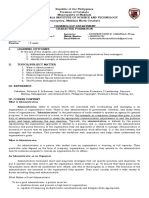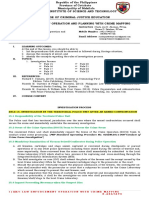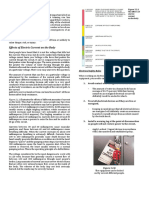Module - 4 Fire Technology
Uploaded by
Anthony EhaponModule - 4 Fire Technology
Uploaded by
Anthony EhaponRepublic of the Philippines
Province of Cotabato
Municipality of Makilala
MAKILALA INSTITUTE OF SCIENCE AND TECHNOLOGY
Conception, Makilala North Cotabato
BACHELOR OF SCIENCE IN CRIMINOLOGY
Course No. : CDI- 6 Instructor : MIGUEL D. HAYAG JR., RCRIM, MSCJ
Course Title : Fire Technology and Arson Investigation Mobile Number : 09463882328
Credits Unit : 3 Units Email Address : hayagmiguel@gmail.com
Module No :4
Duration : 9-10 weeks
LEARNING OUTCOMES
At the end of this module, you should be able to:
determine the history of fire fighting
explain what is fire protection
determine and explain what is fire prevention and suppression
explain the factor affecting fire protection and control
TOPIC/SUBJECT MATTER
the history of fire fighting
fire protection
fire prevention and suppression
explain the factor affecting fire protection and control
REFERENCES
Alocelja, R. & Villaluz, J. (2015). “Fire Investigation and Fire Technology”. An Instructional Material for
Criminology Students. Wiseman’s Books Trading, Inc.
COURSE CONTENT
FIRE TECHNOLOGY AND ARSON INVESTIGATION
History of Fire Fighting
History of Fire Fighting One of the first
fighting forces was established in Rome, about 500
B.C. the first fire fighters were romans slaves who
were stationed on the walls and the gates of Rome,
these units were called Familia Publica. In 6 A.D.
after an enormous fire devastated Rome, the
emperor Augustus created the vigiles, a firefighting
of 7000 men that was divided into seven regiments.
After the collapse of the Roman Empire,
European cities and towns became disorganized
and nobody coordinated firefighting. Some people were required to put out their cooking and home fires
at night. In some towns night watchmen were employed to raise the alarm if they discovered a fire.
The Great fire of London in 1666 led to the development of fire insurance industries in
England. These companies marked their insured properties with metal badges called fire marks and
formed private fire brigades to protect these properties. It was not until the 1800’s that London insurance
companies began to cooperate and a single London Fire Fighting Establishment was formed.
In France, groups of citizen kept watch for fire outbreaks, and regulation controlled rescue
operations. In the 1600’s a number of serious fires ravage throughout Paris that leads to the king of
France to bought 12 pumps for fire suppression, and a private fire service was established. In 1810,
emperor Napoleon attended a ball at the Austrian embassy. A candle set the curtains ablaze that causes
fire to spread quickly causing a dreadful panic. This incident leads to the creation of the Battalion de
Sapeurs Pompiers and the French Fire Brigade was born.
Better equipment for firefighting was developed in the 1500’s. In 1672, two men in Amsterdam
both called Jan Van der Heidi, invented a flexible hose which could be joined together to form a long
pipe. The German company Daimler invented the first petrol driven pump in 1885, but the pump still had
to be taken to fires by horses. Petrol-powered fire engines were introduced in the early 1900’s.
The Bureau of Fire Protection Republic Act
#6975, the DILG Act of 1990 (chapter 4, section 53-
59) created the Bureau of Fir Protection (BFP) to be
responsible for the prevention and suppression of all
destructive fires and to enforce the laws on fire.
Fire Protection Is the descriptive term
referring to the various methods used by the bureau
to stop, extinguish and control destructive fire for
eventual prevention of loss of life and property, It has
the following objectives;
1. To prevent destructive fire from starting
2. To extinguish on going destructive fire
3. To continue a destructive fire at the place where it began
4. To prevent loss of life and property when fire starts
Fire prevention and Suppression. This refers to various
safety measures utilized to stop harmful or destructive fires
from starting. The laws related with the fire prevention and fire
protection in the Philippine setting includes R.A. 9514, Fire
Code of the Philippines, and PD # 1096 building code of the
Philippines (19, February 1977).
The Bureau of Fire Protection is composed of well-
trained fire fighters. In some countries like United States, fire
fighting units are divided into engine companies and ladder
companies. Engine companies operated trucks called engines,
which carry a pump and hoses for spraying water on a fire.
Ladder companies use ladder trucks with various lengths.
Fire Affecting Fire Protection and Control Fire protection and control is affected by the accumulation of
fire hazards in a building or area. Fire hazard is any condition or act that increases or may cause increase
in the probability that fire will occur or which may obstruct, delay, or interfere with fire fighting operations
and the safeguarding of life and property.
Conditions of Fire Hazards
1. Existence of dangerous or unlawful amount of combustion or explosives in the building not
designed to store such materials
2. Defective or improperly installed facilities/equipment
3. Lack of adequate exit facilities
4. Obstruction at fire escapes or other designated opening for fire fighters
5. Dangerous accumulation of rubbish waste and other highly combustible materials
6. Accumulation of dust in ventilation system or of grease in the kitchen
7. Building under repair
8. Very old building or building is primarily made of combustible materials
EVALUATION/ASSESSMENT:
Test I- Multiple choice (1point each)
Instruction: Choose the letter of the correct answer.
1. It refers to the law related to the fire prevention and fire protection in the Philippine setting.
a. R.A 6975 c. R.A. 9514
b. P.D.1096 d. both b and c
2. In what year the better equipment for firefighting was developed?
a. 1900’s c. 1500’s
b. 1800’s d.1600’s
3. Who was invented a flexible hose which could be joined together to form a long pipe?
a. Emperor Augustus c. Jan Van der Heidi
b. Napoleon Bonaparte d. Battalion de Sapeurs Pompiers
4. In what year was the first petrol-driven pump invented?
a. 1660 c. 1810
b. 1990 d. 1885
5. It is a condition that increases the probability that fire will occur?
a. Fire prevention c. fire danger
b. Fire suppression d. fire hazard
6. Who was the French Chemist who proved in 1777 that burning is the result of rapid combination of
oxygen with other substance?
a. Antoine Lavoisier c. John Walker
b. Thomas Alva Edison d. Gabriel Daniel Fahrenheit
7. Petrol-powered fire engines were introduced in the early?
a. 1660’s c. 1885
b. 1800’s d. 1990’s
8. What state of matter of fuel is the most easy to be set on fire?
a. Solid c. gas
b. Liquid d. fuel
9. This law is known as the new Fire Code of the Philippines.
a. PD 1613 c. PD 765
b. PD 1185 d. RA 9514
10. It refers to various safety measures utilized to stop harmful or destructive fires from starting.
a. Fire prevention c. Fire protection
b. Fire suppression d. both a and b
“MDHJR”
End
You might also like
- History of Fire Protection Engineering - Professional Practice Content From Fire Protection EngineeringNo ratings yetHistory of Fire Protection Engineering - Professional Practice Content From Fire Protection Engineering7 pages
- Y8 TEST Combustion and Periodic Table Sept2020 TestNo ratings yetY8 TEST Combustion and Periodic Table Sept2020 Test13 pages
- FIRE SAFETY COMM 105 Assignment - 012651No ratings yetFIRE SAFETY COMM 105 Assignment - 0126513 pages
- FIRE TECHNOLOGY AND ARSON MANAGEMENT (CDI 18) MODULE 6 NewNo ratings yetFIRE TECHNOLOGY AND ARSON MANAGEMENT (CDI 18) MODULE 6 New8 pages
- Natural Disasters Sequencing Comprehension Presentation in Colorful Realistic StyleNo ratings yetNatural Disasters Sequencing Comprehension Presentation in Colorful Realistic Style34 pages
- Fire Protection and Arson Investigation QuizzesNo ratings yetFire Protection and Arson Investigation Quizzes11 pages
- M1 LESSON 3 Classifications Causes Prevention Control and Extinguishments of FireNo ratings yetM1 LESSON 3 Classifications Causes Prevention Control and Extinguishments of Fire21 pages
- Fire Fighting Operations and ExtinguishmentNo ratings yetFire Fighting Operations and Extinguishment8 pages
- Explosives Midterms All Manuscript and ModuleNo ratings yetExplosives Midterms All Manuscript and Module81 pages
- Lessons Learned From Understanding Warehouse Fires100% (1)Lessons Learned From Understanding Warehouse Fires6 pages
- Fire Safety Awareness Health Care (Autosaved) (Autosaved)No ratings yetFire Safety Awareness Health Care (Autosaved) (Autosaved)93 pages
- 1 - Cdi-7 Drug Education and Vice ControlNo ratings yet1 - Cdi-7 Drug Education and Vice Control6 pages
- 1 - Cdi-7 Drug Education and Vice ControlNo ratings yet1 - Cdi-7 Drug Education and Vice Control3 pages
- Assignment-15 Fire Safety: Sub: Building Construction-VNo ratings yetAssignment-15 Fire Safety: Sub: Building Construction-V11 pages
- Boeckhoff 2010-Operational Experience of The 51-60 DF From MANNo ratings yetBoeckhoff 2010-Operational Experience of The 51-60 DF From MAN11 pages
- Analysis of Fire Hazard and Safety Requirements of A Sea Vessel Engine RoomsNo ratings yetAnalysis of Fire Hazard and Safety Requirements of A Sea Vessel Engine Rooms8 pages
- CoC Oral Exam Preparation - (Part - 15) - Fire & Safety - Marine StudyNo ratings yetCoC Oral Exam Preparation - (Part - 15) - Fire & Safety - Marine Study12 pages
- 5. ISO-19579-2006 Lưu Huỳnh Thiếu Độ Tái LậpNo ratings yet5. ISO-19579-2006 Lưu Huỳnh Thiếu Độ Tái Lập9 pages
- Pratt & Whitney Canada: Maintenance Manual MANUAL PART NO. 3034342No ratings yetPratt & Whitney Canada: Maintenance Manual MANUAL PART NO. 303434210 pages
- Manual 001: Facility and Well Site Inspections: Enforcement and Surveillance BranchNo ratings yetManual 001: Facility and Well Site Inspections: Enforcement and Surveillance Branch190 pages
- What Is Delay Period in Ic Engine - Google SearchNo ratings yetWhat Is Delay Period in Ic Engine - Google Search1 page
- Enclosed Ground Flares: Zero Smoke, Low Noise and No Visible FlameNo ratings yetEnclosed Ground Flares: Zero Smoke, Low Noise and No Visible Flame4 pages
- (Commercial Vehicle Technology) Michael Hilgers, Wilfried Achenbach - The Diesel Engine-Springer Vieweg (2021)No ratings yet(Commercial Vehicle Technology) Michael Hilgers, Wilfried Achenbach - The Diesel Engine-Springer Vieweg (2021)85 pages
- Safety Data Sheet: 3M™ Easy Clean Coating ECC-1000No ratings yetSafety Data Sheet: 3M™ Easy Clean Coating ECC-100010 pages
- History of Fire Protection Engineering - Professional Practice Content From Fire Protection EngineeringHistory of Fire Protection Engineering - Professional Practice Content From Fire Protection Engineering
- Y8 TEST Combustion and Periodic Table Sept2020 TestY8 TEST Combustion and Periodic Table Sept2020 Test
- FIRE TECHNOLOGY AND ARSON MANAGEMENT (CDI 18) MODULE 6 NewFIRE TECHNOLOGY AND ARSON MANAGEMENT (CDI 18) MODULE 6 New
- Natural Disasters Sequencing Comprehension Presentation in Colorful Realistic StyleNatural Disasters Sequencing Comprehension Presentation in Colorful Realistic Style
- M1 LESSON 3 Classifications Causes Prevention Control and Extinguishments of FireM1 LESSON 3 Classifications Causes Prevention Control and Extinguishments of Fire
- Lessons Learned From Understanding Warehouse FiresLessons Learned From Understanding Warehouse Fires
- Fire Safety Awareness Health Care (Autosaved) (Autosaved)Fire Safety Awareness Health Care (Autosaved) (Autosaved)
- Assignment-15 Fire Safety: Sub: Building Construction-VAssignment-15 Fire Safety: Sub: Building Construction-V
- Boeckhoff 2010-Operational Experience of The 51-60 DF From MANBoeckhoff 2010-Operational Experience of The 51-60 DF From MAN
- Analysis of Fire Hazard and Safety Requirements of A Sea Vessel Engine RoomsAnalysis of Fire Hazard and Safety Requirements of A Sea Vessel Engine Rooms
- CoC Oral Exam Preparation - (Part - 15) - Fire & Safety - Marine StudyCoC Oral Exam Preparation - (Part - 15) - Fire & Safety - Marine Study
- Pratt & Whitney Canada: Maintenance Manual MANUAL PART NO. 3034342Pratt & Whitney Canada: Maintenance Manual MANUAL PART NO. 3034342
- Manual 001: Facility and Well Site Inspections: Enforcement and Surveillance BranchManual 001: Facility and Well Site Inspections: Enforcement and Surveillance Branch
- Enclosed Ground Flares: Zero Smoke, Low Noise and No Visible FlameEnclosed Ground Flares: Zero Smoke, Low Noise and No Visible Flame
- (Commercial Vehicle Technology) Michael Hilgers, Wilfried Achenbach - The Diesel Engine-Springer Vieweg (2021)(Commercial Vehicle Technology) Michael Hilgers, Wilfried Achenbach - The Diesel Engine-Springer Vieweg (2021)
- Safety Data Sheet: 3M™ Easy Clean Coating ECC-1000Safety Data Sheet: 3M™ Easy Clean Coating ECC-1000









































































































